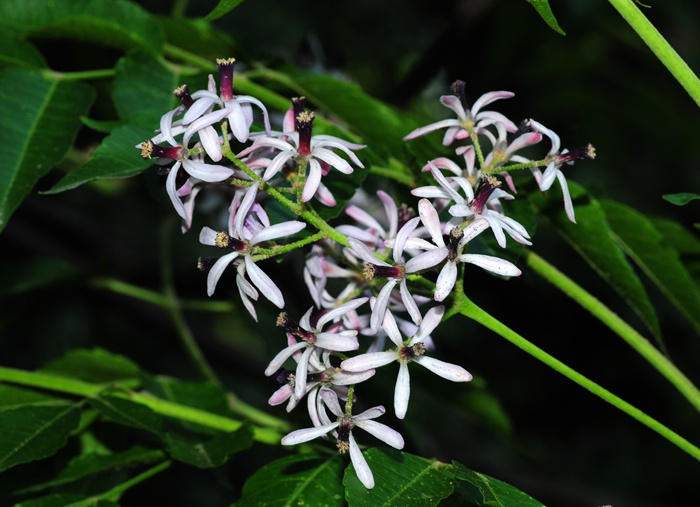- Scientific Name: Melia azedarach L.
- Ref: Sp. Pl.:384. 1753
- Synonyms:
- Azedara speciosa Raf.
- Azedarach commelinii Medik.
- A. deleteria Medik.
- A. fraxinifolia Moench
- A. sempervirens Kuntze
- A. sempervirens var. glabrior (C.DC.) Kuntze
- A. sempervirens f. incisodentata Kuntze
- Melia aethiopica Welw.
- M. angustifolia Schumach. & Thonn.
- M. arguta DC.
- M. australasica A.Juss.
- M. azedarach var. australasica (A.Juss.) DC.
- M. azedarach var. glabrior C.DC.
- M. azedarach var. umbraculifera G.W.Knox
- M. azedarach f. umbraculifera (G.W.Knox) Rehder
- M. bogoriensis Koord. & Valeton
- M. bombolo Welw.
- M. candollei A.Juss.
- M. chinensis Siebold ex Miq.
- M. cochinchinensis M.Roem.
- M. flaccida Zipp. ex Span.
- M. floribunda Carrière
- M. guineensis G.Don
- M. japonica G.Don
- M. javanica M.Roem.
- M. orientalis M.Roem.
- M. robusta Roxb. ex G.Don
- M. sambucina Blume
- M. sempervirens Sw.
- M. superba Roxb.
- M. toosendan Siebold & Zucc.
- English Common Name: syringa, melia, syringa berrytree, chinaberry tree, bead-tree, Cape lilac, Persian lilac, Indian lilac
- Chinese Common Name: 楝 liàn, 苦楝 kǔliàn, 楝树 liànshù
- Japanese Common Name: センダン [栴檀] sendan, オウチ/アフチ [楝] ōchi/afuchi
- Family: Meliaceae
- Genus: Melia
- Distribution: Mixed evergreen broad-leaved and deciduous forests, sparse forests, field margins, roadsides; 500-2100 m. Anhui, Fujian, S Gansu, Guangdong, Guangxi, Guizhou, Hainan, S Hebei, Henan, Hubei, Hunan, Jiangsu, Jiangxi, S Shaanxi, Shandong, S Shanxi, Sichuan, Taiwan, Yunnan, SE Xizang, Zhejiang [Bhutan, India, Indonesia, Laos, Nepal, Papua New Guinea, Philippines, Sri Lanka, Thailand, Vietnam; tropical Australia, Pacific islands (Solomon Islands)].
Trees to 10 m tall, deciduous. Bark brownish gray, longitudinally exfoliating. Branches spreading; branchlets with leaf scars. Leaves odd-pinnate, 2-pinnate or 3-pinnate, 20-40 cm; leaflets opposite; leaflet blades ovate, elliptic, or lanceolate, 3-7 × 2-3 cm but terminal one usually slightly larger, both surfaces with stellate trichomes when young but glabrescent, secondary veins 12-16 on each side of midvein, outspread and ascending, base ± oblique and cuneate to broadly cuneate, margin crenate or sometimes entire, apex shortly acuminate. Thyrses ± ca. 1/2 as long as leaves, glabrous or covered with short lepidote pubescence. Flowers fragrant. Calyx 5-parted; sepals ovate to oblong-ovate, outside puberulent, apex acute. Petals lilac-colored, obovate-spatulate, 0.9-1.3 cm, both surfaces puberulent but usually outside more densely so. Staminal tube purple, 7-8 mm, with longitudinal stripes, glabrous or subglabrous, apical margin with 10 narrow lobes; lobes conic, further 2- or 3-lobed; anthers 10, inserted on inner side of lobes and alternate to lobes, narrowly elliptic, apex slightly mucronulate. Ovary spherical, glabrous, 5-8-locular, with 2 ovules per locule; style acerose; stigma capitate, not included within filament tube, apex 5-dentate. Drupe globose to ellipsoid, 1-3 × 0.8-1.5 cm; endocarp ligneous. Seed ellipsoid. Fl. Mar-May, fr. Oct-Dec. (Flora of China)
